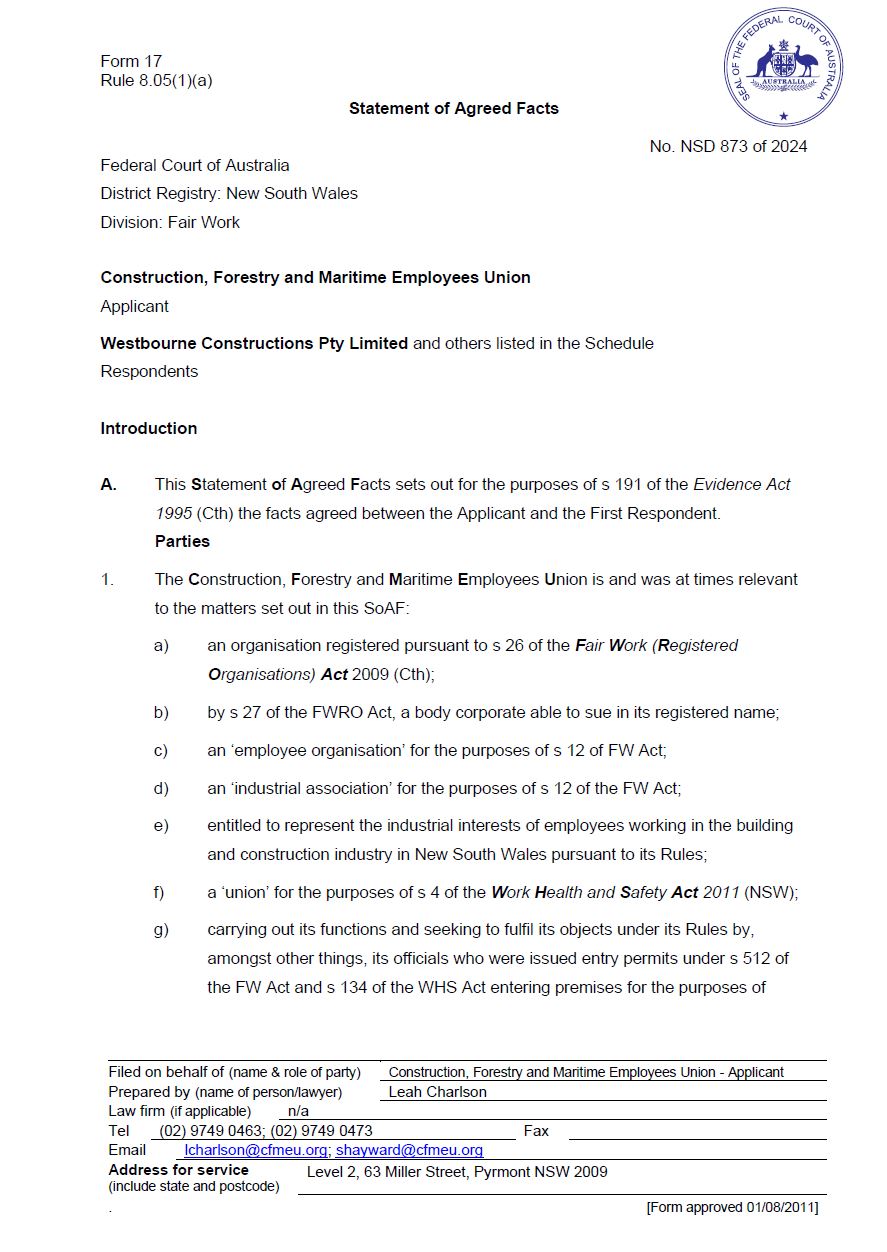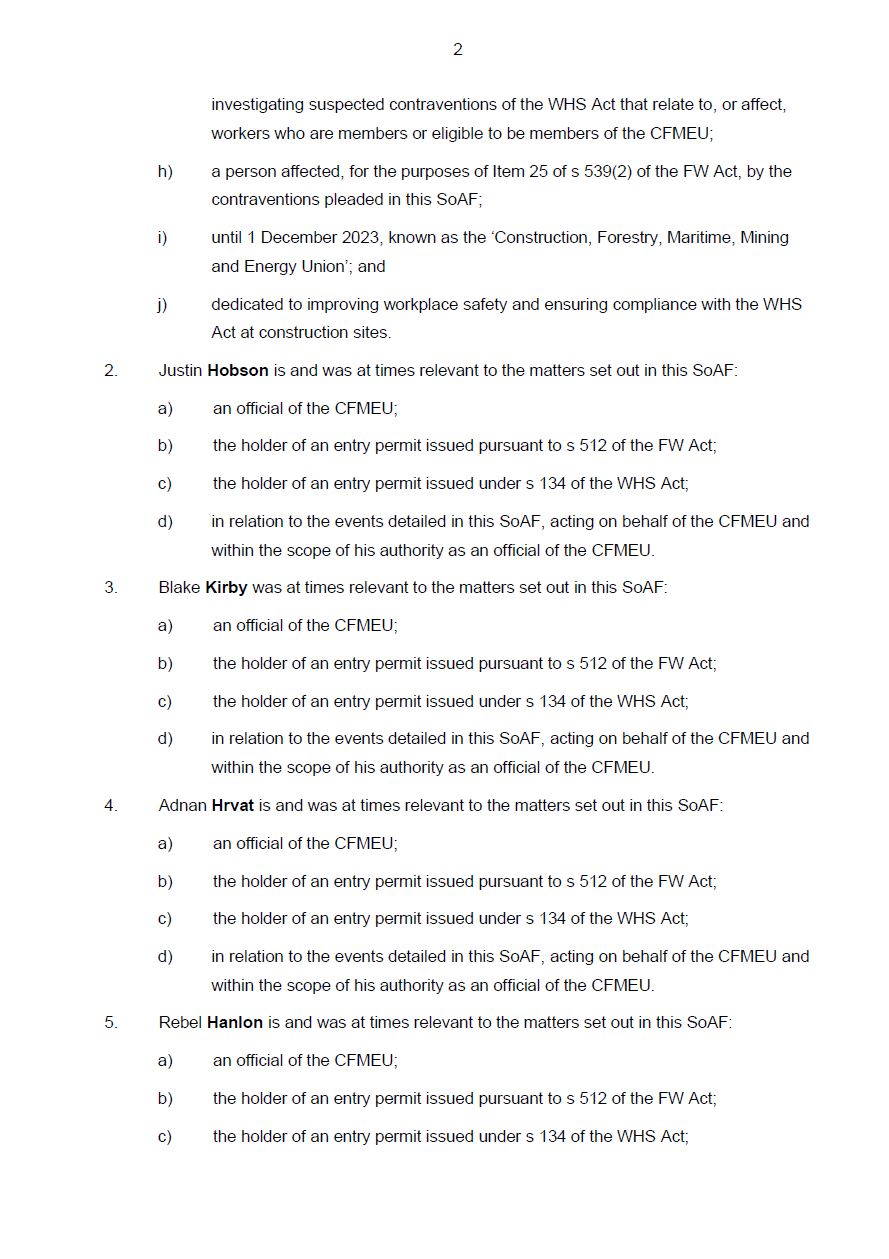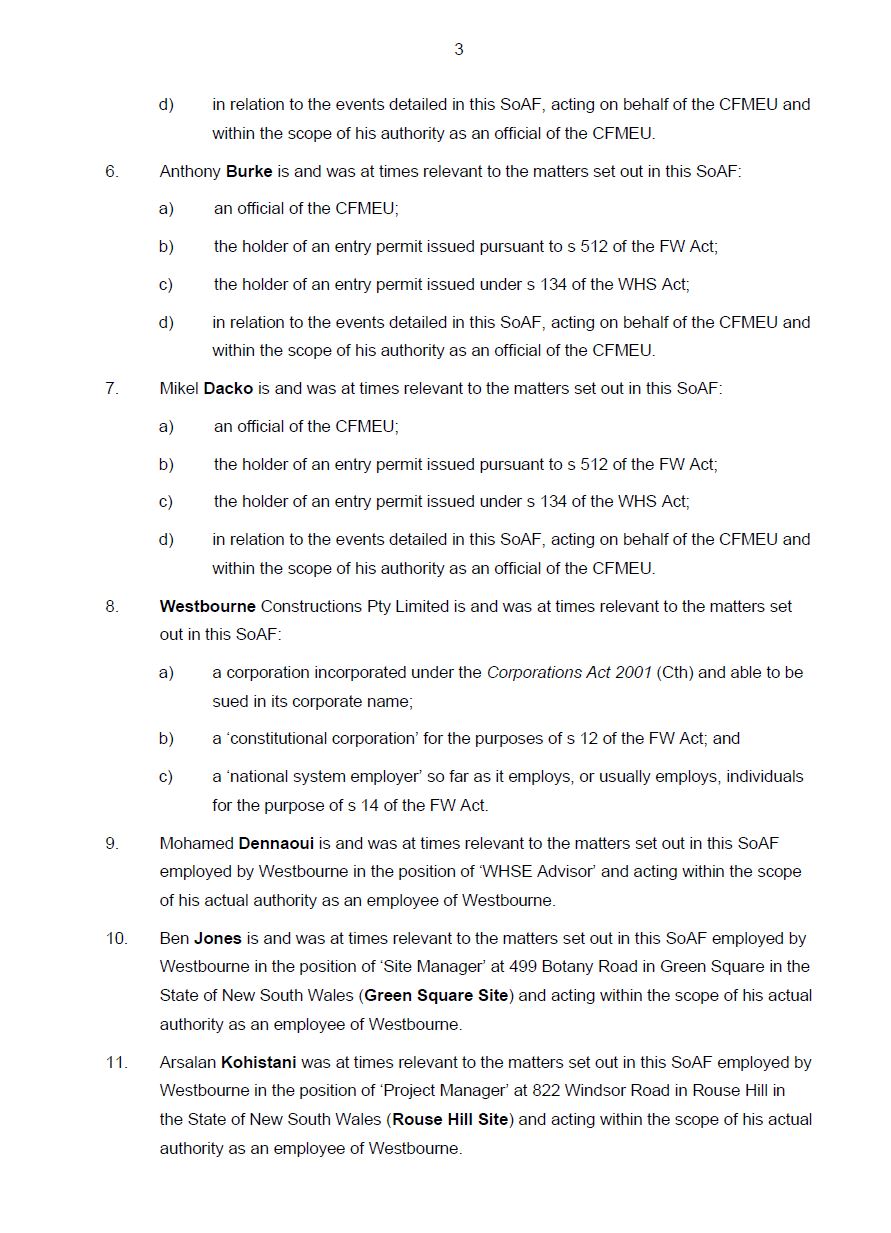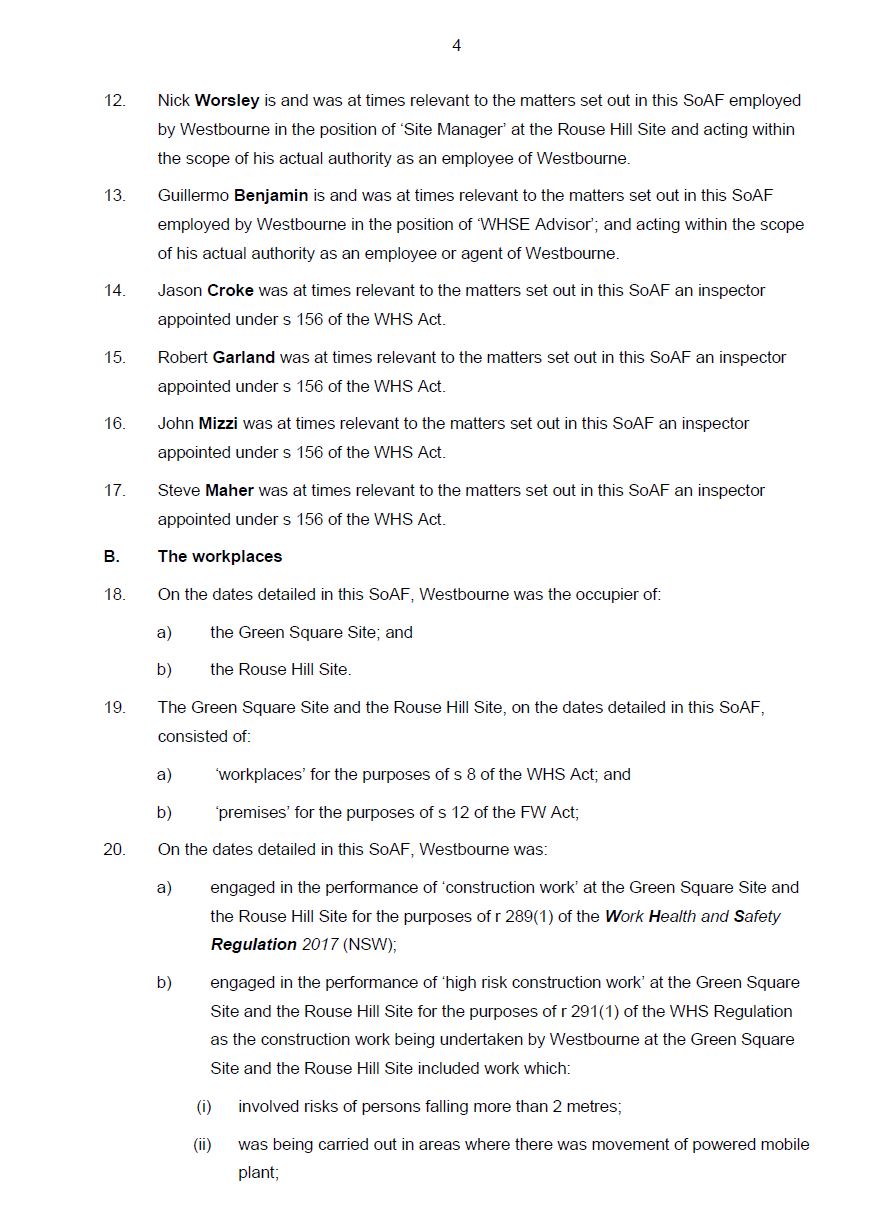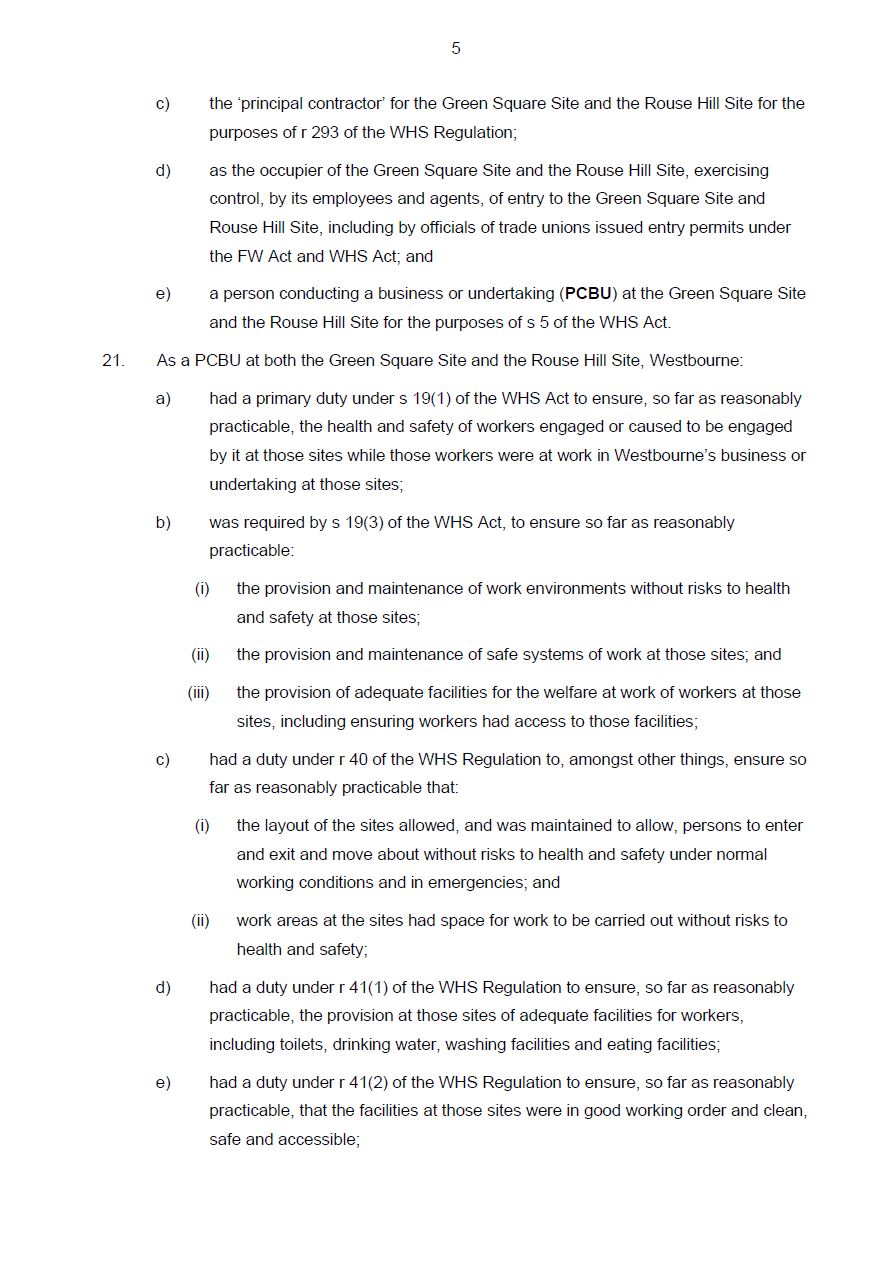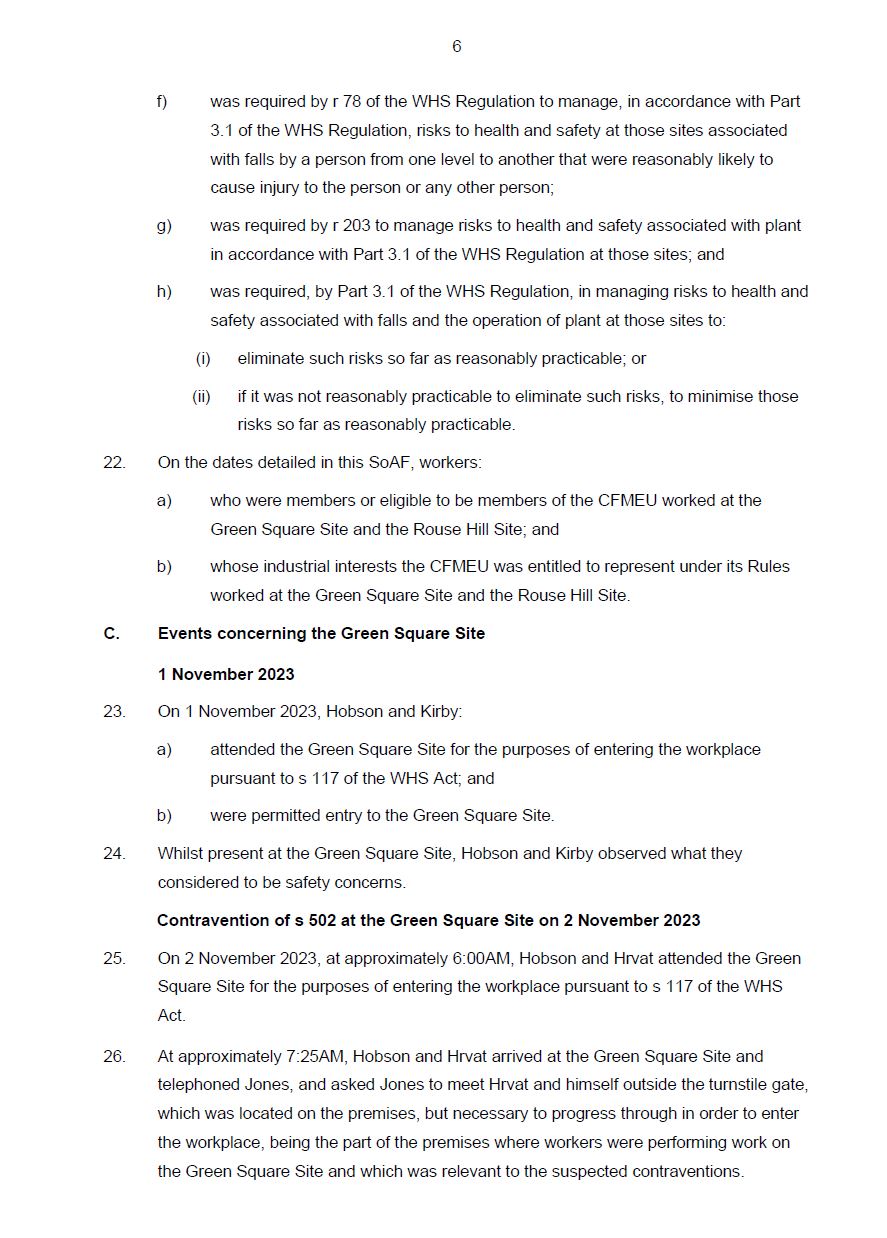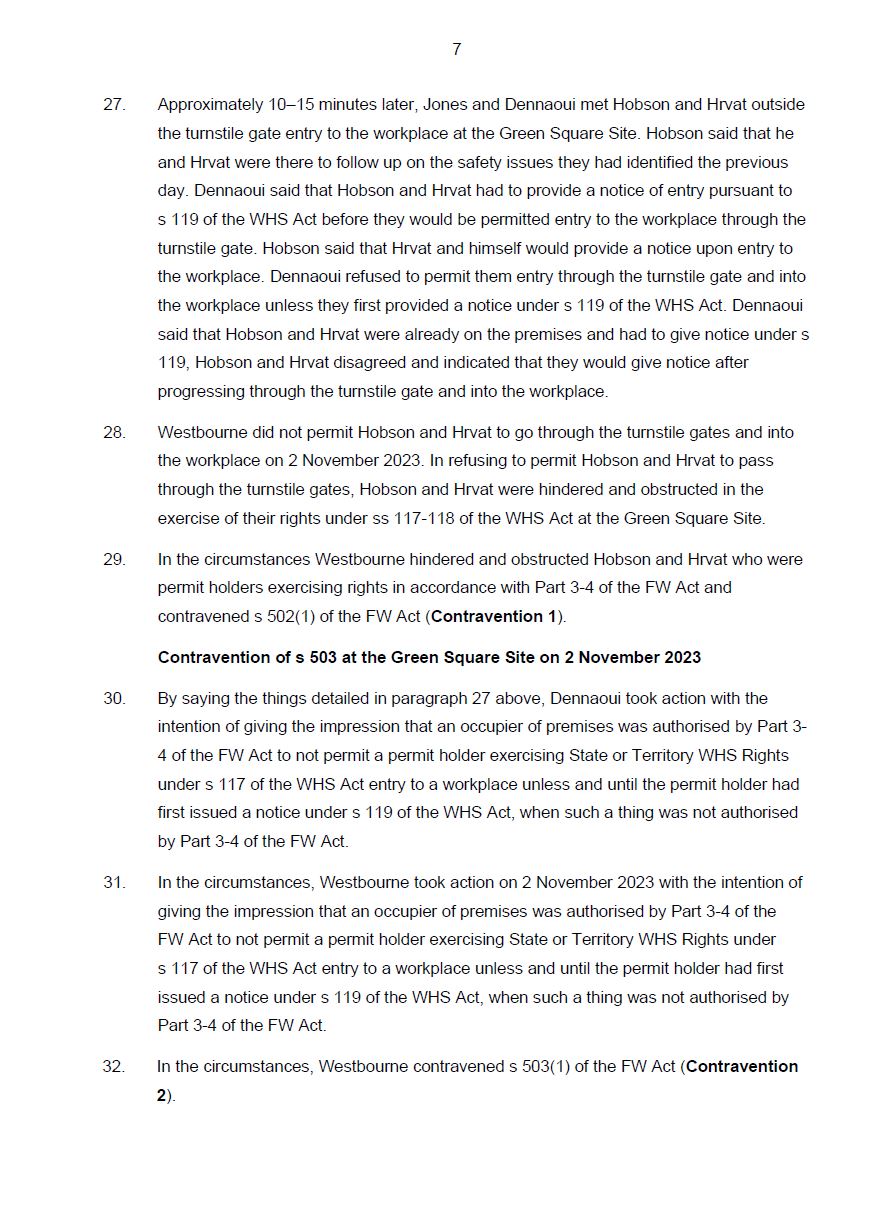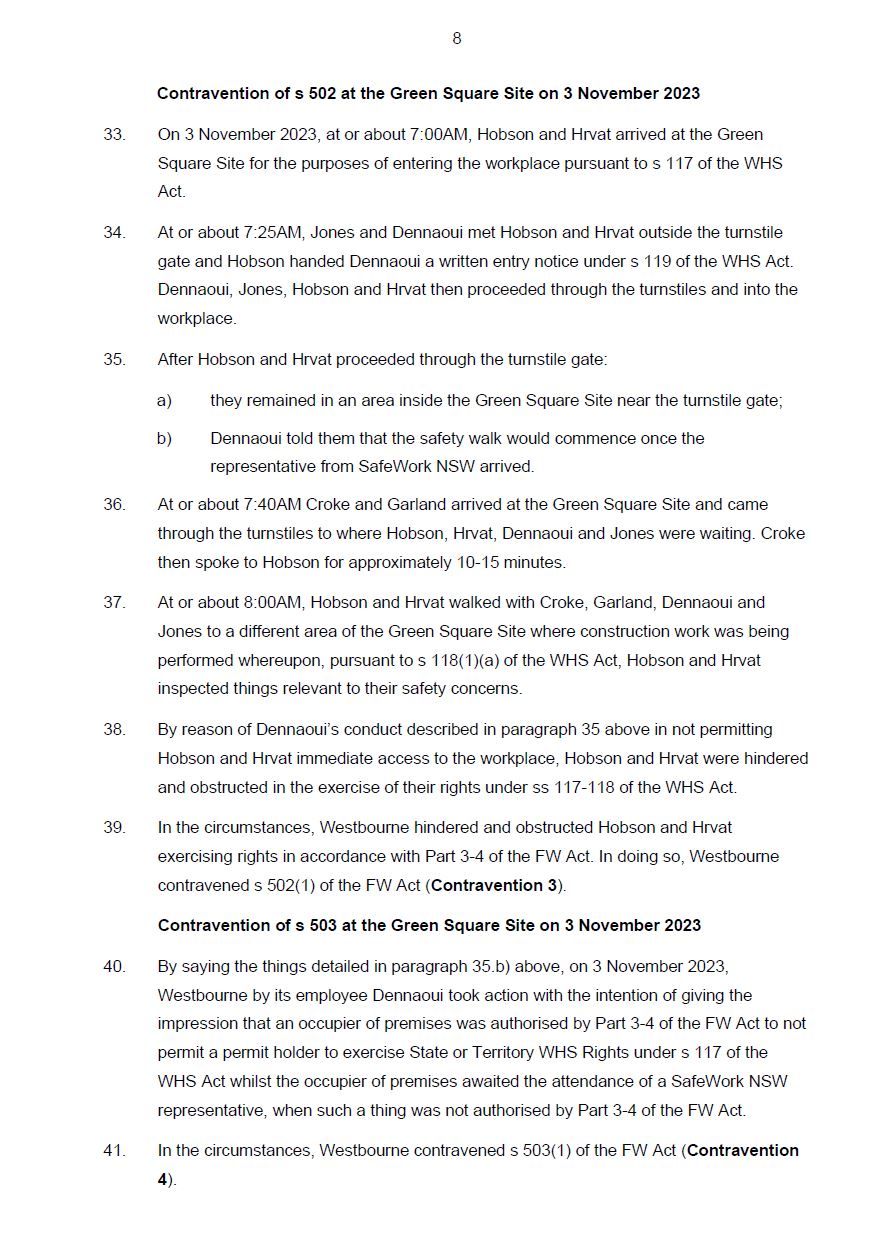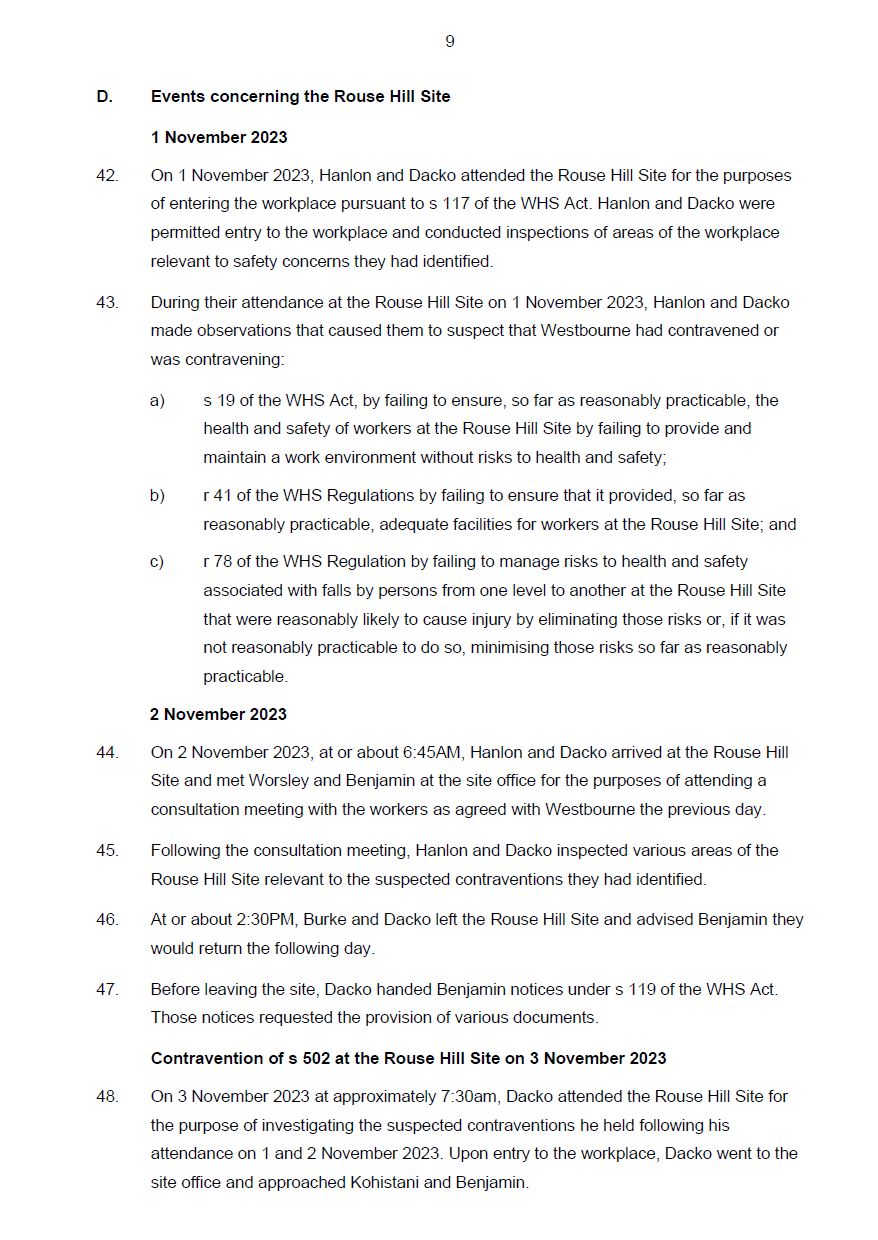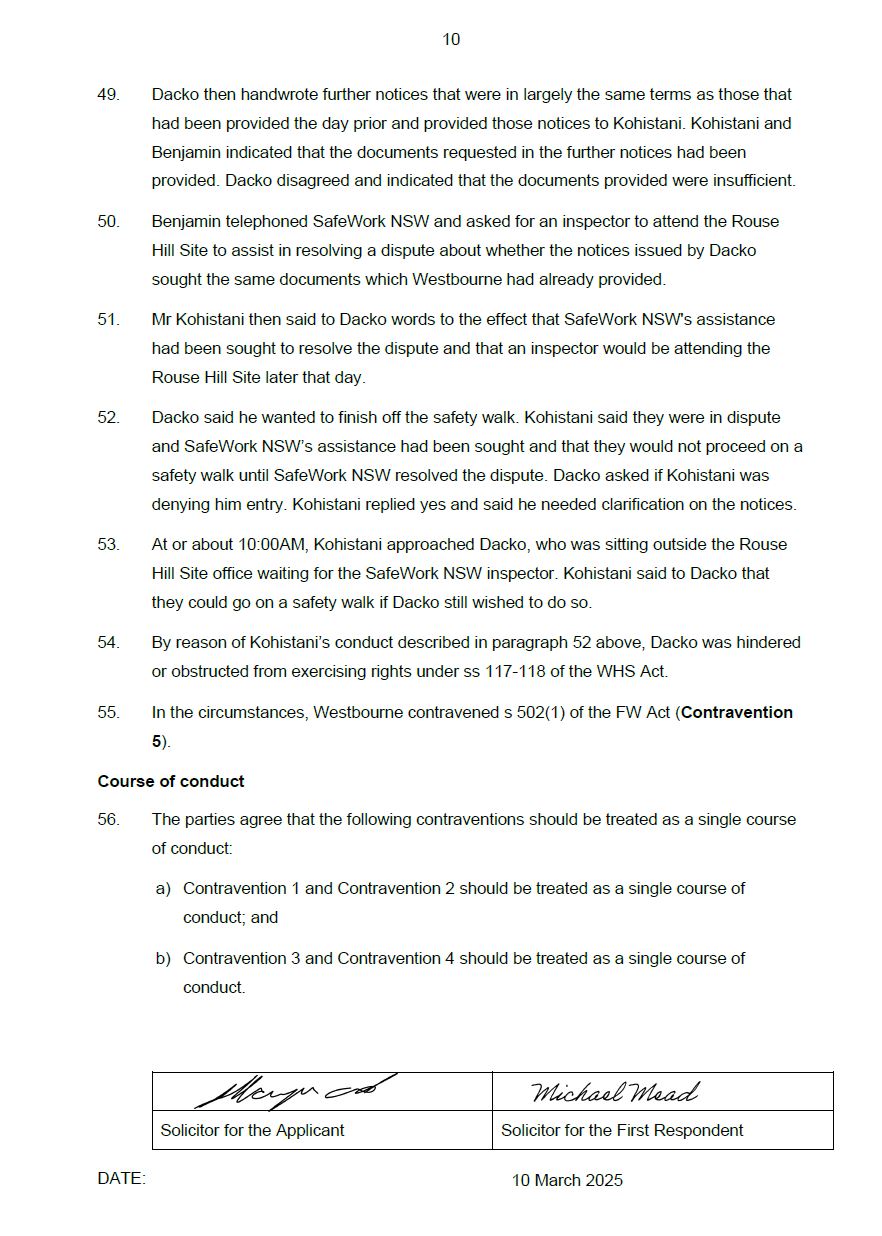Federal Court of Australia
Construction, Forestry and Maritime Employees Union v Westbourne Constructions Pty Limited [2025] FCA 831
File number: | NSD 873 of 2024 |
Judgment of: | WIGNEY J |
Date of judgment: | 14 July 2025 |
Catchwords: | INDUSTRIAL LAW – officials of the applicant attended the sites to investigate suspected work health and safety contraventions – respondent engaged in high risk construction work – false impression that notice under s 119 of the Work Health and Safety Act 2011 (NSW) was required before entry – assertion that a ‘safety walk’ could only commence once SafeWork NSW representatives were present – hinderance and obstruction of rights afforded by Part 3-4 of the Fair Work Act 2009 (Cth) – contraventions of ss 502(1) and 503(1) of the Fair Work Act 2009 (Cth) - consideration of the principles for fixing appropriate pecuniary penalties – proposed and agreed declaratory relief granted |
Legislation: | Fair Work Act 2009 (Cth) ss 12, 502, 502(1), 503, 503(1), 512, 539(2), 546(2)(b), 546(3) Federal Court of Australia Act 1976 (Cth) s 21 Crimes Act 1914 (NSW) s 4AA Evidence Act 1995 (NSW) s 191 Work Health and Safety Act 2011 (NSW) ss 4, 117, 119, 134 |
Cases cited: | Australian Building and Construction Commissioner v Pattinson [2022] 274 CLR 450 Australian Competition and Consumer Commission v MSY Technology Proprietary Limited [2012] 201 FCR 378 Australian Competition and Consumer Commission v The Construction, Forestry, Mining and Energy Union [2006] FCA 1730 Australian Securities and Investments Commission v Rich [2004] NSWSC 836 Commonwealth v Director, Fair Work Building Industry Inspectorate [2015] 258 CLR 482 Construction, Forestry, Maritime, Mining and Energy Union v Richard Crookes Constructions Proprietary Limited [2022] FCA 992 Forster v Jododex Australia Pty Limited (1972) 127 CLR 421 Rural Press Limited v Australian Competition and Consumer Commission [2003] 216 CLR 53 |
Division: | Fair Work Division |
Registry: | New South Wales |
National Practice Area: | Employment and Industrial Relations |
Number of paragraphs: | 49 |
Date of hearing: | 14 July 2025 |
Counsel for the applicant: | Mr P Boncardo |
Solicitor for the applicant: | Ms S Hayward, CFMEU |
Counsel for the respondents: | Mr M Minucci |
Solicitor for the respondents: | Kingston Reid |
ORDERS
NSD 873 of 2024 | ||
| ||
BETWEEN: | CONSTRUCTION, FORESTRY AND MARITIME EMPLOYEES UNION Applicant | |
AND: | WESTBORNE CONSTRUCTIONS PTY LIMITED First Respondent BEN JONES Second Respondent JASON CROKE (and others named in the Schedule) Third Respondent | |
order made by: | WIGNEY J |
DATE OF ORDER: | 14 JULY 2025 |
THE COURT DECLARES THAT:
1. On 2 November 2023, at the Green Square Site at 499 Botany Road, Green Square, New South Wales (Green Square Site), the First Respondent contravened s 502(1) of the Fair Work Act 2009 (Cth) by its Work Health Safety and Environment adviser Mohamed Dennaoui refusing to permit Justin Hobson and Adnan Hrvat, who were holders of entry permits issued under s 512 of the FW Act, to pass through the turnstile gates and into the workplace, being the part of the Green Square Site where workers were performing work, thereby hindering Hobson and Hrvat in the exercise of their rights under s 117 of the Work Health and Safety Act 2011 (NSW) (the first contravention).
2. On 2 November 2023, at the Green Square Site, the First Respondent contravened s 503(1) of the FW Act by Dennaoui saying to Hobson and Hrvat that Hobson and Hrvat had to provide a notice of entry pursuant to s 119 of the WHS Act before they would be permitted entry into the workplace through the turnstile gate, thereby taking action with the intention of giving the impression that an occupier of premises was authorised to not permit a permit holder exercising rights under s 117 of the WHS Act entry to a workplace unless and until the permit holder had first provided a notice of entry, when such a thing was not authorised by Part 3-4 of the FW Act (the second contravention).
3. On 3 November 2023, at the Green Square Site, the First Respondent contravened s 502(1) of the FW Act by Dennaoui not permitting Hobson and Hrvat, who were holders of entry permits issued under s 512 of the FW Act, immediate access to the workplace, thereby hindering Hobson and Hrvat in the exercise of their rights under s 117 of the WHS Act (the third contravention).
4. On 3 November 2023, at the Green Square Site, the First Respondent contravened s 503(1) of the FW Act by Dennaoui telling Hobson and Hrvat that the safety walk would commence once the representative from SafeWork NSW arrived, thereby taking action with the intention of giving the impression that an occupier of premises was entitled to not permit a permit holder to exercise rights under s 117 of the WHS Act whilst the occupier of premises awaited the attendance of a SafeWork NSW representative, when such a thing was not authorised by Part 3-4 of the FW Act (the fourth contravention).
5. On 3 November 2023, at the Rouse Hill Site at 822 Windsor Road, Rouse Hill, New South Wales, the First Respondent contravened s 502(1) of the FW Act by its Project Manager Arsalan Kohistani telling Mikel Dacko, who was the holder of an entry permit issued under s 512 of the FW Act that:
(a) they were in dispute;
(b) SafeWork NSW’s assistance had been sought;
(c) an inspector of SafeWork NSW would be attending the Rouse Hill site later that day;
(d) they would not proceed on a safety walk until SafeWork NSW resolved the dispute; and
(e) Kohistani was denying Dacko entry,
thereby hindering and obstructing Dacko in the exercise of his rights under s 117 of the WHS Act (the fifth contravention).
THE COURT ORDERS THAT:
1. The respondent pay a pecuniary penalty of $10,000 in respect of the first contravention.
2. The respondent pay a pecuniary penalty of $10,000 in respect of the second contravention
3. The respondent pay a pecuniary penalty of $7,500 in respect of the third contravention.
4. The respondent pay a pecuniary penalty of $7,500 in respect of the fourth contravention.
5. The respondent pay a pecuniary penalty of $15,000 in respect of the fifth contravention.
6. The pecuniary penalties payable by the respondent be paid to the applicant.
Note: Entry of orders is dealt with in Rule 39.32 of the Federal Court Rules 2011.
REASONS FOR JUDGMENT
(Delivered ex tempore; revised from transcript)
WIGNEY J:
1 The applicant, the Construction Forestry and Maritime Employees Union is, as its name suggests, a trade union the members of which include workers in the construction industry. The respondent, Westbourne Construction Pty Limited, as its name also suggests, is a company that operates a building construction business. The Union commenced this proceeding alleging that Westbourne contravened ss 502(1) and 503(1) of the Fair Work Act 2009 (Cth). The alleged contravening conduct involved representatives of Westbourne hindering or obstructing the attempt by Union officers to exercise their rights as the holders of entry permits to enter premises occupied by Westbourne, and falsely giving the Union officers the impression that they were not permitted to enter the premises in the circumstances.
2 Westbourne admitted that it contravened ss 502 and 503 of the Fair Work Act as alleged by the Union. The parties were also in agreement as to the relief that they say the Court should grant in respect of those contraventions. In particular, they agreed that the Court should make declarations in respect of the contravention and should order Westbourne to pay pecuniary penalties to the Union in respect of the contraventions. They also agreed on the amount of the pecuniary penalties that they submit the Court should impose.
3 The task of the Court, in simple terms, is to determine whether it is appropriate in the circumstances to make the declarations in respect of the contraventions and whether the agreed penalties are within the appropriate range of penalties which would achieve the objective of deterrence.
THE STATUTORY CONTEXT
4 It is necessary to first identify the relevant statute provisions which entitle permit holders to enter premises in certain circumstances, as well as the provisions which allow for the imposition of penalties on those who hinder or obstruct permit holders in the exercise of their statutory rights. In New South Wales, the starting point is the Work Health and Safety Act 2011 (NSW). Section 117 of the Safety Act provides for a right of entry to permit holders. It is in the following terms:
117 Entry to inquire into suspected contraventions
(1) A WHS entry permit holder may enter a workplace for the purpose of inquiring into a suspected contravention of this Act that relates to, or affects, a relevant worker.
(2) The WHS entry permit holder must reasonably suspect before entering the workplace that the contravention has occurred or is occurring.
5 A “WHS entry permit holder” is a person who has been issued a WHS permit pursuant to s 134 of the Safety Act: see Safety Act s 4. Section 134 of the Safety Act provides that:
134 Issue of WHS entry permit
The authorising authority may issue a WHS entry permit to a person if the authorising authority has taken into account the matters in section 132 and is satisfied about matters in section 133.
6 The “authorising authority”, for the purposes of s 134 of the Safety Act, is the Industrial Relations Commission: s 4 of the Safety Act.
7 Section 119 of the Safety Act requires the permit holder to give notice of the entry after entering the workplace. It provides as follows:
119 Notice of entry
(1) A WHS entry permit holder must, as soon as is reasonably practicable after entering a workplace under this Division, give notice of the entry and the suspected contravention, in accordance with the regulations, to—
(a) the relevant person conducting a business or undertaking, and
(b) the person with management or control of the workplace.
(2) Subsection (1) does not apply if to give the notice would—
(a) defeat the purpose of the entry to the workplace, or
(b) unreasonably delay the WHS entry permit holder in an urgent case.
(3) Subsection (1) does not apply to an entry to a workplace under this Division to inspect or make copies of documents referred to in section 120.
8 It is next necessary to consider the relevant provisions of the Fair Work Act, particularly as the contraventions by Westbourne which are the subject of these proceedings are contraventions of the Fair Work Act, not the Safety Act. As has already been noted, the Union alleged, and Westbourne admitted, that it contravened ss 502 and 503 of the Fair Work Act. Sections 502 and 503 of the Fair Work Act are civil penalty provisions, a contravention of which can lead to the imposition of pecuniary penalties.
9 Section 502 of the Fair Work Act provides as follows:
502 Person must not hinder or obstruct permit holder etc.
(1) A person must not intentionally hinder or obstruct a permit holder exercising rights in accordance with this Part, or otherwise act in an improper manner.
Note: This subsection is a civil remedy provision (see Part 4-1).
(2) To avoid doubt, a failure to agree on a place as referred to in paragraph 483(5)(b), 483C(6)(b) or 483E(6)(b) does not constitute conduct referred to in subsection (1).
(3) Without limiting subsection (1), that subsection extends to conduct that occurs after an entry notice is given but before a permit holder enters premises.
10 A “permit holder” is defined in s 12 of the Fair Work Act as a “person who holds an entry permit”. An entry permit is defined in s 12 in the following terms: “see section 512”. Section 512 of the Fair Work Act provides as follows:
512 FWC may issue entry permits
The FWC may, on application by an organisation, issue a permit (an entry permit) to an official of the organisation if the FWC is satisfied that the official is a fit and proper person to hold the entry permit
11 Section 503 of the Fair Work Act provides as follows:
503 Misrepresentations about things authorised by this Part
(1) A person must not take action:
(a) with the intention of giving the impression; or
(b) reckless as to whether the impression is given;
that the doing of a thing is authorised by this Part if it is not so authorised.
Note: This subsection is a civil remedy provision (see Part 4-1).
(2) Subsection (1) does not apply if the person reasonably believes that the doing of the thing is authorised.
12 As noted earlier, ss 502 and 503 of the Fair Work Act are both civil penalty provisions: see Items 25, column 1 of the table in s 539(2) of the Fair Work Act. Subsection 539(2) of the Fair Work Act provides that certain persons may apply to the Court for certain orders in relation to the contraventions of civil remedy provisions identified in the table in s 539(2).
13 In the case of a contravention of ss 502 and 503, a “person affected by the contravention” may relevantly apply to the Court for orders “including the maximum penalty” of 60 penalty units: see Item 25, columns 3 and 4 of the table in s 539(2) of the Fair Work Act. The penalty unit for contraventions of civil penalty provision in November 2023 was $313: see Fair Work Act s 12 and Crimes Act 1914 (NSW) s 4AA. Subsection 546(2)(b) provides that if the contravening person is a body corporate the maximum pecuniary penalty is five times the maximum number of penalty units referred to in the relevant item in column 4 in the table in subs 539(2).
14 It follows (and was common ground) that the maximum penalty which may be ordered in respect of Westbourne’s contraventions of both s 502 and 503 of the Fair Work Act is $93,900.
RELEVANT FACTS IN RESPECT OF THE CONTRAVENTIONS
15 The facts relevant to Westbourne’s contraventions were not in dispute. The parties signed and filed a Statement of Agreed Facts for the purposes of s 191 of the Evidence Act 1995 (NSW). A copy of the Statement of Agreed Facts is appended as Appendix A to these Reasons for Judgment.
16 The Union's written submissions helpfully contained the following summary of the relevant facts with which Westbourne did not dispute:
Background
5. Westbourne is a national system employer that operates a building and construction business. In 2023, it was the occupier and controller of two building sites. One was located at 499 Botany Road, Green Square and the other at 822 Windsor Road in Rouse Hill. At both sites, Westbourne was engaged in what the Work Health and Safety Regulation 2017 (NSW) classifies as “high risk construction work”, being work of a kind that involves risks of persons falling more than 2 metres and work that is carried out in areas where there is movement of powered mobile plant. Westbourne controlled access and egress to the sites, including entry by union officials who were the holders of permits issued under both the FW Act and WHS Act.
6. Westbourne was also a “person conducting a business or undertaking” at both sites. This had a number of implications under the WHS Act and WHS Regulation. Amongst other things, Westbourne had non-delegable and absolute duties to ensure, so far as reasonably practicable, the health and safety of persons engaged or caused to be engaged to perform work at the sites; the maintenance of an environment of work without risks to health and safety; the provision of safe systems of work; and of adequate facilities for the welfare of workers performing work. Westbourne also had specific duties in relation to the provision of adequate toilets, drinking water and eating facilities and to ensure those facilities were clean, safe and accessible. It was also required to manage risks of falls from height and risks associated with the use of plant in accordance with the stipulations of the Regulations.
7. Workers who performed work at the sites were members or eligible to be members of the CFMEU.
2 November 2023 contraventions at the Green Square Site
8. On 1 November 2023, two CFMEU officials who held permits issued under the FW Act and WHS Act entered the Green Square Site in accordance with s 117 of the WHS Act to investigate suspected contraventions of the WHS Act that related to or affected workers performing work on that site. Whilst they were on site, they observed further safety concerns.
9. The following day, two CFMEU officials who were permit holders, Mr Hobson and Mr Hrvat, re-attended the Green Square Site for the purpose of entering it to investigate the safety concerns observed the previous day. The “workplace” for the purposes of s 8 of the WHS Act at the Green Square Site (being the place where work was carried out for Westbourne) was accessible via a turnstile gate. After alerting Westbourne’s ‘Site Manager’, Mr Jones, to their presence and purpose, Mr Hobson and Mr Hrvat were approached by Mr Jones and Mr Dennaoui Westbourne’s ‘WHSE Advisor’.
10. Mr Dennaoui told Mr Hobson and Mr Hrvat, incorrectly, that they needed to provide a notice of entry under s 119 of the WHS Act before they would be permitted entry to the workplace. Mr Hobson pointed out, correctly, that the requirement to give notice under s 119 only arose after entry to the workplace. Mr Hobson said that the notice would be provided upon entry. Mr Dennaoui refused to permit entry, reiterating wrongly that notice under s 119 was required to be given before entry to the workplace.
11. The upshot of Mr Dennaoui’s conduct was that Mr Hobson and Mr Hrvat were unable to investigate suspected contraventions of the WHS Act and were hindered and obstructed in exercising rights under ss 117-118 of the WHS Act. Mr Dennaoui’s conduct was intentional. There was, in the circumstances, a contravention of s 502(1) of the FW Act by Westbourne by reason of the intentional conduct of Mr Dennaoui.
12. Further, Mr Dennaoui intentionally gave the erroneous impression that an occupier like Westbourne could refuse entry to a permit holder seeking to enter a workplace until the representation was wrong and misleading and not authorised by Part 3-4 of the FW Act. This was, in the circumstances, a contravention of s 503(1) of the FW Act by Westbourne.
13. Westbourne’s contraventions of both ss 502(1) and 503(1) were part of a single course of conduct, in the sense they were both factually and legally related and involved a single incursion into wrongdoing.
3 November 2023 contraventions at the Green Square Site
14. Undeterred by their unlawful exclusion from the Green Square Site the day before, Mr Hobson and Mr Hrvat re-attended the site the following day, 3 November 2023, for the purposes of entering the workplace under s 117 of the WHS Act to investigate suspected contraventions of the WHS Act.
15. On this occasion, Mr Jones and Mr Dennaoui allowed them entry to the workplace via the turnstile gate and Mr Hobson and Mr Hrvat provided Mr Jones and Mr Dennaoui notices under s 119 of the WHS Act.
16. After entering the workplace, Mr Dennaoui then announced that the “safety walk” would only commence once representatives from SafeWork NSW arrived. The upshot of this instruction was that Mr Hobson and Mr Hrvat were delayed in exercising rights under ss 117-118 of the WHS Act for a period of around 35 minutes. This resulted in Mr Hobson and Mr Hrvat being hindered and obstructed in exercising rights under ss 117-118 of the WHS Act. Mr Dennaoui’s conduct was intentional. In the result, Westbourne contravened s 502(1) of the FW Act.
17. Further, Mr Dennaoui falsely asserted that Mr Hobson and Mr Hrvat were not allowed to commence the “safety walk” (and thus exercise powers under s 118 of the WHS Act) until a SafeWork NSW representative had attended. In uttering this misrepresentation, Mr Dennaoui acted with the intention of giving the impression that an occupier such as Westbourne could not permit a permit holder to exercise rights under s 117 of the WHS Act whilst the occupier awaited the attendance of a SafeWork NSW representative. That representation was wrong and misleading and not authorised by Part 3-4 of the FW Act. This was, in the circumstances, a contravention of s 503(1) of the FW Act by Wes[t]bourne.
18. Westbourne’s contraventions both of ss 502(1) and 503(1) on 3 November 2023 were also part of a single course of conduct.
Contravention of s 502(1) at the Rouse Hill Site
19. Also on 3 November 2023, CFMEU official, Mr Dacko, who also held permits under the FW Act and WHS Act, attended the Rouse Hill Site for the purposes of investigating suspected contraventions of the WHS Act which he had identified during his attendances at that site on 1-2 November 2023.
20. On attending site, he went to the site office and spoke with Westbourne’s ‘Project Manager’, Mr Kohistani, and its ‘WHSE Advisor’, Mr Benjamin. Mr Dacko provided s 119 WHS Act notices to Mr Kohistani. These identified similar contraventions to those which Mr Dacko had sought to investigate on 1-2 November 2023. A dispute ensued about whether documents referred to in the notices had been provided and Mr Benjamin contacted SafeWork NSW. Mr Kohistani said that they would not proceed until SafeWork NSW had resolved the dispute. Mr Dacko insisted, consistently with rights under ss 117-118 of the WHS Act, that he should be permitted to proceed to investigate the suspected contraventions and was told by Mr Kohistani that his entry was denied whilst Mr Kohistani sought “clarification” on the s 119 notices.
21. Mr Dacko, who had sought entry to the Rouse Hill Site at around 7:30AM, was compelled to wait until 10:00AM before Mr Kohistani permitted him to exercise the rights conferred by s 118(1) of the WHS Act. This was in circumstances where no SafeWork NSW representative attended. Mr Kohistani’s conduct in making Mr Dacko wait and precluding him from exercising rights was intentional.
22. In the result, Mr Dacko was required to wait, as a result of Mr Kohistani’s intentional conduct, for over 2-hours before being permitted to exercise the rights conferred on him by s 118(1) of the WHS Act. He was therefore hindered and obstructed in his exercise of rights. This constituted a contravention by Westbourne of s 502(1) of the FW Act.
(Footnotes omitted.)
RELEVANT PRINCIPLES
17 The principles which apply when determining the issues before the Court were not in dispute and therefore need only be addressed in short terms.
Declarations of contravention
18 The Court has a wide discretionary power to make declarations under s 21 of the Federal Court of Australia Act 1976 (Cth). Before making a declaration, even by consent, the Court must be satisfied that: first, the proceeding involves a real controversy as opposed to a hypothetical or theoretical question; second, that the applicant has a real interest in raising the controversy or question; and third, that there is a proper contradictor: see Forster v Jododex Australia Pty Limited (1972) 127 CLR 421 at 437-438.
19 The fact that a respondent who has a real interest in opposing the declaration nevertheless consents to the making of the declaration does not mean that there is no contradictor: Australian Competition and Consumer Commission v MSY Technology Proprietary Limited [2012] 201 FCR 378 at [30]-[33]. Where the declaration concerns a contravention of a civil penalty provision, the Court must be satisfied that the respondent contravened that provision even if the respondent consents to the making of the declaration. The material that provides the basis for the Court’s satisfaction can be a statement of agreed facts and admissions: Australian Securities and Investments Commission v Rich [2004] NSWSC 836 at [15].
20 Declarations relating to contraventions of legislative provisions are likely to be appropriate where they: serve to record the Court’s disapproval of the contravening conduct; vindicate the regulator’s claim that the respondent contravened the provision; assist the regulator to carry out its duties; and deter other persons from contravening the provisions: Australian Competition and Consumer Commission v The Construction, Forestry, Mining and Energy Union [2006] FCA 1730 at [6] and the cases cited therein. Here the Union is not a regulator, but I can see no reason why the same principles would not apply to a trade union in a case such as this.
21 Finally, the Court must be satisfied that a proposed declaration of contravention identifies the conduct that constituted the contravention, or the gist of the findings that amounted to the contravention: see Rural Press Limited v Australian Competition and Consumer Commission [2003] 216 CLR 53 at [89].
Agreed penalties
22 The principles that the Court must apply in considering whether to impose an agreed pecuniary penalty jointly proposed by the parties are explained in Commonwealth v Director, Fair Work Building Industry Inspectorate [2015] 258 CLR 482. In short, the Court must consider and determine whether the agreed penalty is within the range of possible penalties that the Court could reasonably impose in all the circumstances. If the agreed penalty is within that range, the public policy of promoting the predictability of outcomes in civil penalty proceedings makes it highly desirable for the Court to accept the parties’ joint proposal and impose the agreed penalty. The Court is nevertheless not bound by the parties’ agreement in respect of the size of the penalty.
Pecuniary penalties generally
23 In considering and determining whether the agreed penalty falls within the range of appropriate penalties in the circumstances, it is necessary to have regard to the applicable principles concerning the fixing of pecuniary penalties. Those principles are also settled: see Australian Building and Construction Commissioner v Pattinson (2022) 274 CLR 450.
24 In short summary, the purpose of imposing a civil penalty is to promote the public interest in compliance with the relevant Act by the deterrence of further contraventions of a like kind. The Court must, in effect, attempt to put a price on a contravention that is sufficiently high to deter repetition by the contravener and by others who might be tempted to similarly contravene. The penalty must not be one which would be regarded by the contravener, or others, as an acceptable cost of doing business. The penalty must not, however, be greater than is necessary to achieve that object of deterrence.
25 An appropriate penalty is said to be one that strikes an appropriate balance between oppressive severity and the need for deterrence in the particular case. In determining the size of the penalty which would serve the objective of deterrence, the Court must have regard to both the circumstances of the contravener and the contravention.
26 Without intending to be exhaustive, where the contravener is a corporation, the factors concerning the circumstances of the contravener which are generally relevant factors when determining the size of the penalty which would serve the objective of deterrence, include: the size and financial position of the corporation; whether the corporation has a corporate culture conducive to compliance with the relevant Act; whether the contravener has engaged in similar conduct in the past; and whether the contravener has demonstrated contrition and cooperated with the relevant authorities.
27 Likewise, without intending to be exhaustive, the factors concerning the circumstances of the contravention which are generally relevant to determining the size of the penalty which would serve the objective of deterrence, include: whether the contravening conduct was systematic, deliberate or covert; the period over which the contravening conduct occurred; whether the contravention arose out of the conduct of senior management; whether the contravener profited from the contravention, and if so, the extent of profit; and whether the contravention caused any loss or injury.
28 It should be emphasised that both the factors relating to the circumstances of the contravener and those relating to the circumstances of the contravention, are relevant only to the extent that they bear on the question of the size of the penalty that is necessary to achieve the objective of deterrence. The purpose of imposing a pecuniary penalty does not include retribution or punishment. Further, the pecuniary penalty need not be proportionate to the nature and circumstances of the contravention, at least in the sense that the principle of proportionality is understood in the criminal law.
29 The maximum penalty may also be a relevant consideration in determining the size of the penalty, though it does not constrain the exercise of the discretion beyond requiring some reasonable relationship between the theoretical maximum and the final penalty imposed. The maximum penalty would generally only be appropriate in the case of a contravention which warranted the strongest possible deterrence.
DECLARATION OF CONTRAVENTION BY WESTBOURNE
30 Westbourne admitted that it contravened ss 502 and 503 of the Fair Work Act on both 2 November 2023 and 3 November 2023 at the building site referred to as the Green Square Site. It also admitted that it contravened s 502 of the Fair Work Act on 3 November 2023 at the building site referred to as the Rouse Hill Site. The terms of Westbourne’s admissions are reflected in the terms of the agreed declarations the parties submitted the Court should make. The agreed declarations are in the following terms:
Agreed Declarations
1. On 2 November 2023, at the Green Square Site at 499 Botany Road, Green Square, New South Wales (Green Square Site), the First Respondent contravened s 502(1) of the Fair Work Act 2009 (Cth) by its Work Health Safety and Environment adviser Mohamed Dennaoui refusing to permit Justin Hobson and Adnan Hrvat, who were holders of entry permits issued under s 512 of the FW Act, to pass through the turnstile gates and into the workplace, being the part of the Green Square Site where workers were performing work, thereby hindering Hobson and Hrvat in the exercise of their rights under s 117 of the Work Health and Safety Act 2011 (NSW) (the first contravention).
2. On 2 November 2023, at the Green Square Site, the First Respondent contravened s 503(1) of the FW Act by Dennaoui saying to Hobson and Hrvat that Hobson and Hrvat had to provide a notice of entry pursuant to s 119 of the WHS Act before they would be permitted entry into the workplace through the turnstile gate, thereby taking action with the intention of giving the impression that an occupier of premises was authorised to not permit a permit holder exercising rights under s 117 of the WHS Act entry to a workplace unless and until the permit holder had first provided a notice of entry, when such a thing was not authorised by Part 3-4 of the FW Act (the second contravention).
3. On 3 November 2023, at the Green Square Site, the First Respondent contravened s 502(1) of the FW Act by Dennaoui not permitting Hobson and Hrvat, who were holders of entry permits issued under s 512 of the FW Act, immediate access to the workplace, thereby hindering Hobson and Hrvat in the exercise of their rights under s 117 of the WHS Act (the third contravention).
4. On 3 November 2023, at the Green Square Site, the First Respondent contravened s 503(1) of the FW Act by Dennaoui telling Hobson and Hrvat that the safety walk would commence once the representative from SafeWork NSW arrived, thereby taking action with the intention of giving the impression that an occupier of premises was entitled to not permit a permit holder to exercise rights under s 117 of the WHS Act whilst the occupier of premises awaited the attendance of a SafeWork NSW representative, when such a thing was not authorised by Part 3-4 of the FW Act (the fourth contravention).
5. On 3 November 2023, at the Rouse Hill Site at 822 Windsor Road, Rouse Hill, New South Wales, the First Respondent contravened s 502(1) of the FW Act by its Project Manager Arsalan Kohistani telling Mikel Dacko, who was the holder of an entry permit issued under s 512 of the FW Act that:
(a) they were in dispute;
(b) SafeWork NSW’s assistance had been sought;
(c) an inspector of SafeWork NSW would be attending the Rouse Hill site later that day;
(d) they would not proceed on a safety walk until SafeWork NSW resolved the dispute; and
(e) Kohistani was denying Dacko entry,
thereby hindering and obstructing Dacko in the exercise of his rights under s 117 of the WHS Act (the fifth contravention).
(Contravention definitions added.)
31 I am satisfied that it is appropriate for the Court to exercise its discretion to make the agreed declarations. I am satisfied that the proceeding involves a real controversy, that the Union has a real interest in raising the controversy, and that Westbourne was an appropriate and effective contradictor. I am also satisfied that the declarations are appropriate as they serve to: record the Court’s disapproval of Westbourne’s contravening conduct; vindicate the Union’s claims that Westbourne contravened the provisions in question; and will operate to deter Westbourne and other persons who may be in a like position to Westbourne from contravening those provisions in similar or comparable ways in the future. Finally, I am satisfied that the terms of the declarations proposed by the parties are appropriate and adequately identify the conduct that constituted the contraventions.
32 In all the circumstances, it is appropriate for the Court to make the declarations sought by the Union and agreed to by Westbourne.
THE PECUNIARY PENALTIES TO BE PAID BY WESTBOURNE
33 The parties agreed and jointly submitted that the Court should impose the following pecuniary penalties on Westbourne:
(a) $20,000 for its contravention of ss 502(1) and 503(1) on 2 November 2023 at the Green Square site;
(b) $15,000 for its contravention of ss 502(1) and 503(1) on 3 November 2023 at the Green Square site; and
(c) $15,000 for its contravention of s 502(1) on 3 November 2023 at the Rouse Hill site.
34 Both parties filed written submissions in respect of the agreed penalties. While there were some minor differences in the submissions concerning the seriousness of the contraventions, and the significance of specific and general deterrence in the circumstances of this case, ultimately both parties admitted that the agreed penalties were appropriate penalties to secure the objective of deterrence in the circumstances.
35 I am persuaded that it is appropriate to impose pecuniary penalties which, in aggregate, total $50,000 as agreed and submitted by the parties. However, while it is perhaps an exercise in pedantry, I consider it appropriate to impose separate penalties of $10,000 for each of the contraventions of ss 502 and 503 of the Fair Work Act at the Green Square Site on 2 November 2023 (as opposed to a composite penalty of $20,000 for both contraventions), and separate penalties of $7,500 for each of the contraventions of ss 502 and 503 of the Fair Work Act at the Green Square Site on 3 November 2023 (as opposed to a composite penalty of $15,000 for both contraventions). That is because the principles often referred to as the course of conduct and totality principles, to the extent to which they are applicable as tools of analysis in relation to the imposition of pecuniary penalties, do not permit or justify the imposition of composite penalties or aggregate for separate contraventions, other than perhaps where it is not possible to determine the number of contraventions involved in the course of conduct. I am satisfied that a penalty of $15,000 for the contravention of s 502 of the Fair Work Act on 3 November 2023 at the Rouse Hill Site is an appropriate penalty in all the circumstances.
36 I am satisfied that, adjusted as I have indicated, the agreed pecuniary penalties are within the range of penalties that are adequate and appropriate to secure the objective of deterrence. In reaching that conclusion, I have taken the following factors or considerations into account.
37 First, the contraventions were serious contraventions of important provisions of the Fair Work Act.
38 In relation to s 502 of the Fair Work Act, one of the clear objectives of the statutory scheme of which s 502(1) forms part is to secure the health and safety of workers and workplaces, with contraventions of s 502 having the capacity to fundamentally undermine workplace safety: see Construction, Forestry, Maritime, Mining and Energy Union v Richard Crookes Constructions Proprietary Limited [2022] FCA 992 at [173]. Any contravention of s 502(1), particularly one involving entry under the Safety Act to investigate suspected safety contraventions, will, by its very nature, be objectively serious and require higher penalties to secure affected deterrence: see Richard Crookes at [174].
39 The contraventions of s 502 of the Fair Work Act at the Green Square Site on 2 November 2023 were more serious as they resulted in the Union officials being unable to secure entry to the premises at all. The contraventions also involved a relatively senior employee of Westbourne.
40 As for the contraventions of s 503 of the Fair Work Act, those contraventions were serious given that they involved a relatively senior employee at Westbourne intentionally conveying a false impression in respect of the Union officers’ rights to enter the premises. The contravention at the Green Square Site on 2 November 2023 was more serious as it resulted in the official Union officers not securing entry into the premises at all.
41 In my view, the seriousness of the contravening conduct warrants stern penalties to secure the objective of general deterrence. In that regard, I reject Westbourne’s submission that the need for general deterrence is limited given the nature of the contravening conduct.
42 Second, in considering the size of the penalty necessary to secure specific deterrence, it is relevant to have regard to the fact that Westbourne ultimately admitted its contraventions and reached an agreement with the Union in respect of the appropriate penalties. It is also relevant to have regard to the fact that Westbourne has not previously been found to have contravened the Fair Work Act.
43 It is also of some relevance to the need for specific deterrence that the Chief Executive Officer of Westbourne has now apologised for the contravening conduct. That said, while I accept that Westbourne’s Chief Executive Officer’s apology reflects a degree of contrition, given the fairly general nature of the apology and the circumstances in which it was made, I do not accept that it is a particularly weighty consideration in the circumstances. It is also worth noting in this context that there is no evidence to suggest that the Westbourne representatives who were involved in the contravention have been sanctioned or disciplined in respect of their conduct.
44 In all the circumstances, I see little merit in Westbourne’s submission that specific deterrence has no role to play in the imposition of the penalties in the circumstances of this case simply because it has no record of previous contraventions.
45 Third, whilst the parties did not specifically advert to this factor, and there was limited material before the Court in relation to it, I would infer from the agreed facts that Westbourne is a relatively large corporation with significant financial resources at its disposal. That is a relevant consideration because it is well accepted that the Court must fix penalties which put a “price” on the contravention which is sufficiently high to deter any further contraventions of a like kind. The size and financial resources of the contravening corporation are relevant considerations in determining that price.
46 Fourth, I consider that there is a reasonable relationship between the agreed penalties and the maximum penalties having regard to the facts of the contravention and Westbourne’s circumstances.
47 In all the circumstances, I accept that the agreed penalties, which, in aggregate, result in a total penalty of $50,000, are appropriate penalties in the sense that they are likely to secure the objective of both specific and general deterrence. They cannot be said to be greater than necessary to achieve that objective.
48 I should finally note that the parties agreed that pecuniary penalty should be paid to the Union pursuant to s 546(3) of the Fair Work Act.
CONCLUSION AND DISPOSITION
49 Declarations in the form sought by the parties should be made in respect of the contraventions by Westbourne of ss 501 and 502 of the Fair Work Act. Pecuniary penalties totalling $50,000 should be made in respect of those contraventions. Westbourne should pay the pecuniary penalties to the Union.
I certify that the preceding forty-nine (49) numbered paragraphs are a true copy of the Reasons for Judgment of the Honourable Justice Wigney. |
Associate:
Dated: 14 July 2025
SCHEDULE OF PARTIES
NSD 873 of 2024 | |
Respondents | |
Fourth Respondent: | GULLERMO BENJAMIN |
Fifth Respondent: | MAHOAMAD DENNAOUI |
Sixth Respondent: | JOHN MIZZI |
Seventh Respondent: | ARSALAN KOHISTANI |
Eighth Respondent: | NICK WORSLEY |
Ninth Respondent: | SCOTT SIMPSON |
APPENDIX A
